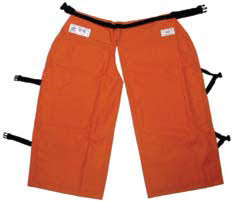Chaps are basic personal protective equipment (PPE) for saw use. High visibility (Hi-Viz) garments are required in certain work places. So, Hi-Viz chaps can be a good choice for some chainsaw users.
Forester is known for their value oriented products. They offer a range of apron, wrap, and bib-style chainsaw chaps, in a variety of colors; including a couple of camo patterns (I guess for guys who want to sneak up on their trees?). The Hi-Viz option is available in a few different styles, so read the descriptions carefully if comparison shopping.
I compared full-wrap styles: one with conventional buckles, and another with zipper-style leg closures. Some pairs of an all-Velcro, 'Slap Chap' closure, now discontinued, might also be found.


Both pairs are labeled as UL Classified to meet ASTM F1897-2014 (USA) and CAN/BNQ 1923-450-M91 Class B (Canada) chainsaw protection standards. 'Also meets or exceeds Part 8 of the WorkSafeBC standard'. They are tagged as meeting Class E, Type 2 of the ANSI/ISEA 107-2015 High Visibility standard.

So sawyers can be seen on either side of the 49th parallel in these.
Philbert
Forester is known for their value oriented products. They offer a range of apron, wrap, and bib-style chainsaw chaps, in a variety of colors; including a couple of camo patterns (I guess for guys who want to sneak up on their trees?). The Hi-Viz option is available in a few different styles, so read the descriptions carefully if comparison shopping.
I compared full-wrap styles: one with conventional buckles, and another with zipper-style leg closures. Some pairs of an all-Velcro, 'Slap Chap' closure, now discontinued, might also be found.


Both pairs are labeled as UL Classified to meet ASTM F1897-2014 (USA) and CAN/BNQ 1923-450-M91 Class B (Canada) chainsaw protection standards. 'Also meets or exceeds Part 8 of the WorkSafeBC standard'. They are tagged as meeting Class E, Type 2 of the ANSI/ISEA 107-2015 High Visibility standard.

So sawyers can be seen on either side of the 49th parallel in these.
Philbert




















